The Australian GST recognises three types of insurance each of which is taxed in a different way.
1. Life insurance is input-taxed. This is because life insurance policies involve a significant element of saving and are in the nature of a financial service. Therefore, life insurance is treated in the same manner as other financial services under the GST.
2. Private health insurance is GST-free. This treatment is consistent with the general treatment of health services under the GST.
3. All other insurance (which will be referred to as general insurance) is fully taxable at the GST rate of 10 per cent.
This paper provides an overview of the treatment of general insurance under the GST.
Introduction
The Australian GST is a value added tax (VAT) system designed so that, as much as possible, tax is collected on the value that is added by registered entities at each stage of the production chain. This is achieved through a two step process. First, a registered entity includes the GST in the price of all of its taxable supplies. Second, a registered entity is entitled to reclaim the GST component of those inputs which it has acquired in making its own taxable supplies. Assuming that a registered entity makes nothing but taxable supplies and that its GST liability exceeds the amount of input tax credits to which it is entitled, the net result is that a registered entity remits exactly the GST due on the value it has added. It is only when a taxable good or service is consumed by an Australian final consumer (who is not entitled to claim input tax credits) that the full amount of GST included in the price is remitted to the Australian Taxation Office.
This basic design is common to all VAT systems. However, there are numerous supplies which jurisdictions choose not to make taxable for either policy reasons or because of valuation difficulties. In these circumstances, there are two alternative treatments under a GST: the supply can be made GST-free (also known as zero-rated) or the supply can be input taxed (also known as exempt).
A GST-free supply is a supply which is not taxable (i.e., GST is not included in the price) but for which the supplier can nonetheless claim input tax credits for tax paid on its inputs. Supplies of goods and services that are GST-free, effectively bear no GST. GST-free supplies under the Australian GST include most supplies of health and educational services and basic food.
In contrast, an input-taxed supply is a supply which is not taxable and for which the supplier cannot claim input tax credits for tax paid on inputs. Since input tax credits are not available in these circumstances, input-taxed supplies lead to tax cascading where they are acquired by a registered entity for the purposes of making taxable supplies. This tax cascading occurs as the price of subsequent taxable supplies will likely include the embedded tax component of the earlier input taxed supply. This means that the amount of GST payable on subsequent supplies is calculated on an amount which already includes some tax. Since this effect is contrary to the design of a VAT system, input taxation is generally used only where it is technically difficult to impose the GST on a given supply but it is inappropriate to allow the supply to be entirely GST-free. Consistent with most OECD countries, supplies of specified financial services as well as residential rents are among the supplies which are input taxed under the Australian GST.
Supplies of general insurance are a type of supply which are often perceived as having valuation difficulties. As a result, most OECD countries with a VAT have chosen to input tax these supplies. The valuation difficulties arise as general insurance premiums contain two components. The first component is the portion of the premium which is transferred to a pooled fund and invested to cover the insured risks. The second component is the portion which reimburses the insurer for administering the pooled fund. From a tax policy perspective, GST should apply only to the second component. In other words, GST should apply to the insurer's value added which is essentially the difference between the amount of premiums collected and the amount of payouts made. However, it is considered too difficult, if not impossible, to determine this value-added on an individual policy basis.
A notable exception to the input taxation approach to supplies of general insurance is New Zealand which imposes its GST on such supplies. New Zealand avoids the valuation difficulties associated with determining the value added component of individual general insurance policies by ensuring that the GST applies only to the value added on a pooled basis. Australia has adopted this alternative approach and has further developed and refined it to achieve greater administrative simplicity.
How GST on general insurance works: The Australian approach
Original Division 78 of the GST Act
The GST treatment of general insurance is set out in Division 78 of A New Tax System (Goods and Services Tax) Act 1999 (the `GSTAct') and was developed by Treasury with the assistance of the Australian insurance industry. Although Division 78 has undergone one major amendment (with other amendments being made from time to time), the underlying conceptual basis is unchanged. Thus, a solid understanding of the original Division 78 is necessary to properly understand the amended Division 78.
As described above, GST is essentially a tax on final consumption. That is, tax is effectively collected on the value added of goods and services provided to consumers. In the context of general insurance, the value added is the difference between the amount of premiums collected by an insurer (and any interest which is earned) and the amount of insurance payouts made by the same insurer. The following diagram illustrates the nature of value added in general insurance.
Diagram 1: Nature of value added in a general insurance
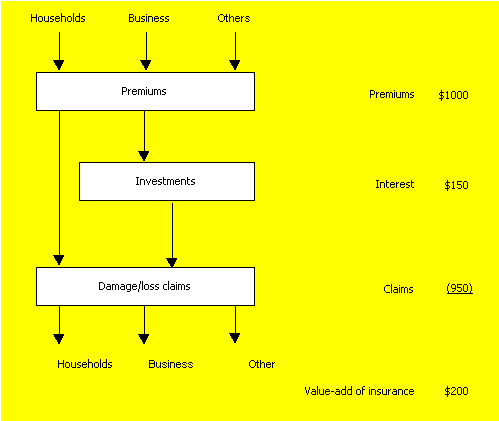
The original Division 78 ensured that tax was collected on the value added margin by essentially dividing general insurance into two components: (1) the payment of the premiums and (2) a payout of a claim. At the time a general insurance policy was issued, GST applied to the premium and was to be remitted by the insurer to the Australian Tax Office. The net tax result then depended on whether or not the insured was registered and entitled to claim input tax credits.
Where the insured was not entitled to a credit, (for example, where the insured was an unregistered individual consumer) too much tax would have been collected. In other words, GST would have been paid on the entire premium and not the margin between premiums and payouts. This overpayment of tax was remedied in the original Division 78 by a provision that stated that when an insurer made a settlement, it was deemed to have made a creditable acquisition which entitled it to an input tax credit equal to 1/11th of the payout. As a result of granting the insurer this credit, the net tax charged would only be on the margin between the premiums and the settlements.
Where the insured was registered and entitled to input tax credits, no net GST revenue would be collected at the time the premium was paid since the tax remitted by the insurer would have been cancelled out by the input tax credit claimed by the insured (assuming the insured was fully taxable). This is the correct GST outcome which arises whenever a taxable supply is made by one registered entity to another.
In addition, at the time a registered insured had a claim paid out under a policy, the original D
ivision 78 deemed such a payment to be consideration for a taxable supply made by the insured. As a result, the insured would have been required to remit GST equivalent to 1/11th of the total payout. Again, no net GST would have been raised as the insurer's input tax credit on the payout would have been equal to the registered insured's GST liability.
In both instances, registered insured and unregistered insured, the correct tax result is achieved. Moreover, the combination of taxing the premium and treating payouts as consideration for a taxable supply results in GST only being applied to an insurer's value added on a pooled basis. Diagrams 2 and 3 illustrate how the original Division 78 achieved the correct tax result.
Diagram 2: The insured is a final consumer
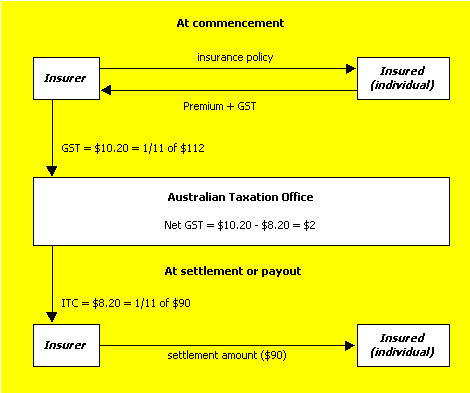
In this example the insurer would remit $10.20 GST (1/11 of $112) to the Tax Office. Since the insured is a final consumer (i.e., unregistered) there is no entitlement to claim an input tax credit for the GST paid on the premium. When a settlement (of $90) is made under the policy, the insurer claims an input tax credit in respect of the settlement amount ($8.20).
There are no further tax consequences on the part of the insured because the insured was not entitled and did not claim an input tax credit for the GST paid on the premium. The net GST raised would be $2 ($10.20 of GST less $8.20 of ITC ). This is the correct outcome as the insurer's value added margin is $22 of which $2 (i.e., 10 per cent) is the GST component.
Diagram 3 : The insured is a registered fully taxable entity
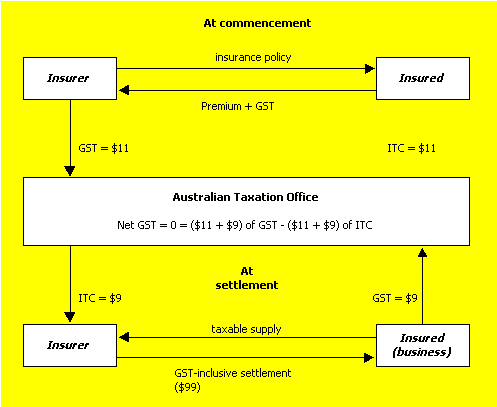
In this case, when the policy was issued, the insurer would remit $11 GST (1/11th of 121) while the insured entity would claim an offsetting input tax credit of $11. As a result, no net GST would be raised at this stage.
Nor would any net GST have been raised at the time of settlement. The insured would have been deemed to have made a taxable supply at the time and would have been required to remit GST equivalent to 1/11th of the settlement amount. The settlement amount paid to the insured would have included an amount equivalent to the insured's GST liability ($9). The insured would have remitted $9 while the insurer would have claimed an offsetting input tax credit of $9. Again, no net GST would have been raised which is the desired tax outcome.
It should be noted that the original Division 78 approach described above applied only to cash payouts. Where the insurer acquired a taxable good or service as part of settling a claim (for example, a replacement good or a repairer's services), the insurer would simply claim an input tax credit under the general GST rules and the same tax result would have been achieved. Moreover, any subsequent transfer to the insured (or a third party) was deemed not to be a taxable supply to ensure that this result was maintained.
Amended Division 78 treatment
Following the development of Division 78, it became apparent to Treasury and the insurance industry that the Division could be refined to achieve greater administrative simplicity. While the same fundamental concepts underlying the original legislation continue to apply, the refined approach utilises the `decreasing adjustment mechanism' (`DAM').
The main changes under the amended Division 78 are that a registered insured no longer has a GST liability when it receives a payout under an insurance policy nor is the insurer entitled to an input tax credit at the time it makes a payout under a policy. As noted above, in the original Division 78, where the insured was registered and fully taxable, the insured's GST liability and the insurer's input tax credit at the time of settlement effectively cancelled each other out. Under the amended version, instead of allowing the insurer to claim an input tax credit and requiring the insured to remit GST, the amendments simply eliminate these provisions. The end result is the same in both cases.
Where the insured is not entitled to an input tax credit in respect of the GST paid on the premium (i.e. the insured is a final consumer), the insurer is entitled to a decreasing adjustment on its net GST liability equal to 1/11th of the payout. The result is the same as under the original Division 78, i.e. only the margin between the premium and the payout is taxed.
Diagrams 4 and 5 on the following pages illustrate how the amended Division 78 works.
Diagram 4 : The insured is a registered fully taxable entity
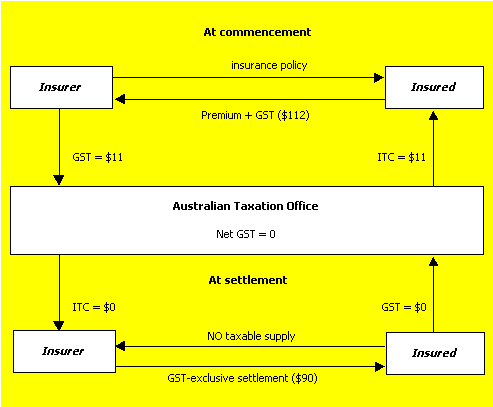
A comparison of the Original and Amended Divisions shows that the same tax result is achieved. In Diagram 4, when the policy is issued, the insurer remits $11 GST (1/11th of 121) while the insured can claim an offsetting input tax credit of $11. Thus, no net GST revenue is raised. However, unlike the original Division 78, there are no further GST consequences at the time of a payout. This approach is administratively much simpler for a registered insured who is making taxable supplies as such an insured is no longer required to remit GST each time it receives a payment from its insurer.
Diagram 5 illustrates how the correct tax result is achieved where the insured is a final consumer. In this case, the insurer remits $10.20 GST (1/11th of $112) at the time the policy is issued. As noted above, too much GST has been remitted at this stage. However, unlike the original Division 78, an input tax credit is not available at the time of a payout. Instead, the identical result is achieved by granting the insurer a decreasing adjustment of $8.20 (i.e., 1/11th of the $90 payout) on its net GST liability.
Diagram 5: The insured is a final consumer
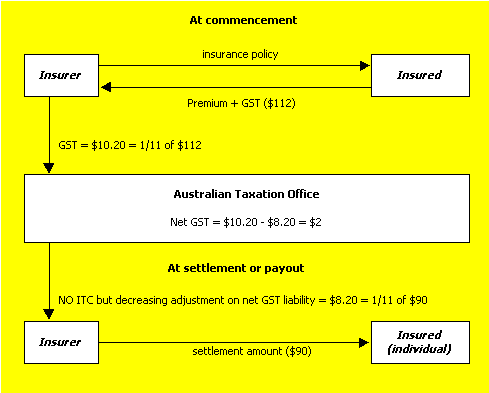
Conclusion
This paper is intended to provide only an overview of the taxation of general insurance under the Australian GST. Division 78 also contains provisions which deal with insurance related issues such as excesses, subrogation and partially input taxed insured entities (for example, financial institutions).
As noted above, the initial GST approach to general insurance was input taxation. While this approach is not desirable from a tax design approach, most jurisdictions felt there was no alternative given the valuation difficulties associated with individual policies. New Zealand was able to avoid this difficulty by approaching the valuation issue on a pooled basis, an approach which has been adopted and refined by Australia. The New Zealand and Australian approachs are based on dividing supplies of general insurance into two components - the payment of a premium and the payout of a claim. This approach ensures that GST is collected only on the insurer's value added. It now remains to be seen whether other jurisdictions will adopt this approach and add further refinements.